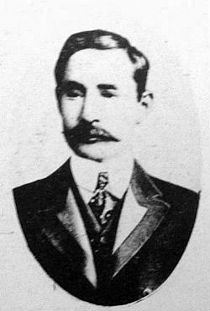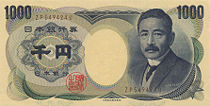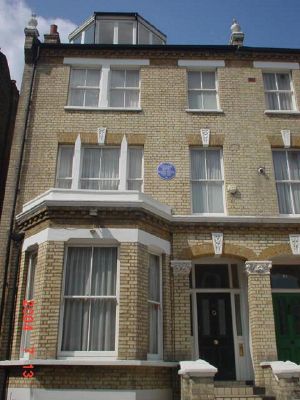Natsume Soseki
Natsume Soseki (夏目 漱石 Natsume Sōseki, February 9, 1867–December 9, 1916) was the pen name of Natsume Kinnosuke (夏目金之助 Natsume Kinnosuke), who is widely considered to be the foremost Japanese novelist of the Meiji Era. He is best known for his novels Kokoro and I Am a Cat. He was also a scholar of British literature and composer of haiku, Chinese-style poetry, and fairy tales. From 1984 until 2004, his portrait appeared on the front of the 1000 yen note.
Early years
Born as Natsume Kinnosuke in the city of Edo (modern-day Tokyo), Natsume began his life as an unwanted child, born to his mother late in her life. His parents foisted him off on a former household servant (Shiobara Masanosuke) and his wife, by whom he was brought up until the age of nine. He returned to his household and was welcomed by his mother although regarded as a nuisance by his father. His mother died when he was fourteen.
In middle school, Natsume became enamored with Chinese literature, and fancied that he might someday become a writer. However, his family disapproved strongly of this course of action, and when Natsume entered the Tokyo Imperial University (now the University of Tokyo) in September of 1884, it was with the intention of becoming an architect. He began studying English at that time, feeling that it might prove useful to him in his future career.
In 1887, Natsume met Masaoka Shiki, a friend who would give him encouragement on the path to becoming a writer, which would ultimately be his career. Shiki tutored him in the art of composing haiku. From this point on, Natsume began signing his poems with the name Soseki, which is a Chinese idiom meaning "stubborn". In 1890, Soseki entered the English literature department, and quickly became a master of the English language. Soseki graduated in 1893, and enrolled for some time as a graduate student and part-time teacher at the Tokyo Normal School.
Soseki began teaching at Ehime Prefecture Middle School in Shikoku, in 1895, which is the setting of his novel Botchan. Along with fulfilling his teaching duties, Soseki published haiku and Chinese poetry in a number of newspapers and periodicals. He resigned his post, in 1896, and began teaching at the Fifth High School in Kumamoto. On June 10 of that year, he married Nakane Kyoko.
Soseki in the United Kingdom, 1901-1902
In 1900, Soseki was sent by the Japanese government to study in Britain. He visited Cambridge and stayed a night there, but gave up the idea of studying at the university because he could not afford it on his government scholarship. He had a miserable time of it in London, spending most of his days indoors buried in books, and his friends feared that he might be losing his mind. He also visited Pitlochry in Scotland.
He lived in four different lodgings. Nevertheless, he solidified his knowledge of English literature and returned to Japan at the end of 1902. Five years later, in his preface to Bungakuron (The Criticism of Literature), he wrote about the period:
- The two years I spent in London were the most unpleasant years in my life. Among English gentlemen I lived in misery, like a poor dog that had strayed among a pack of wolves.
In 1984, Soseki Museum in London opened by Sammy I. Tsunematsu at 80b, The Chase London SW4 0NG.
After his return to the Empire of Japan, he became a professor of English literature at Tokyo Imperial University.
Literary career
Soseki's literary career began in 1905, when he wrote a short story entitled I Am a Cat, which was such a public success that he began serializing it in Hototogisu, a prominent literary journal of the time, founded by his friend Masaoka Shiki. Soon after he published Botchan, another work which won him wide public admiration as well as critical acclaim. He began writing full-time, in 1907, when he left his post at the university for a position with Asahi Shimbun. He began writing one novel a year until his death from a stomach ulcer in 1916.
Major themes in Soseki's works include ordinary people fighting against economic hardship, the conflict between duty and desire, loyalty and group mentality versus freedom and individuality, personal isolation and estrangement, the rapid industrialization of Japan and its social consequences, contempt of Japan's aping of Western culture, and a pessimistic view of human nature.
Soseki's major works include:
|
|
See also
- Anglo-Japanese relations
External links
- Works by Natsume Soseki. Project Gutenberg
- Sōseki page including links to the entire text of Kokoro
- Japanese recordings of several stories from Ten Nights of Dreams, in MP3 format
de:Natsume Sōseki es:Natsume Sōseki eo:Natsume Sôseki fr:Sōseki Natsume ko:나쓰메 소세키 it:Sōseki Natsume ka:ნაცუმე სოსეკი ja:夏目漱石 pl:Sōseki Natsume pt:Natsume Soseki ro:Natsume Sōseki sl:Natsume Soseki tr:Natsume Soseki zh:夏目漱石
Credits
New World Encyclopedia writers and editors rewrote and completed the Wikipedia article in accordance with New World Encyclopedia standards. This article abides by terms of the Creative Commons CC-by-sa 3.0 License (CC-by-sa), which may be used and disseminated with proper attribution. Credit is due under the terms of this license that can reference both the New World Encyclopedia contributors and the selfless volunteer contributors of the Wikimedia Foundation. To cite this article click here for a list of acceptable citing formats.The history of earlier contributions by wikipedians is accessible to researchers here:
The history of this article since it was imported to New World Encyclopedia:
Note: Some restrictions may apply to use of individual images which are separately licensed.


